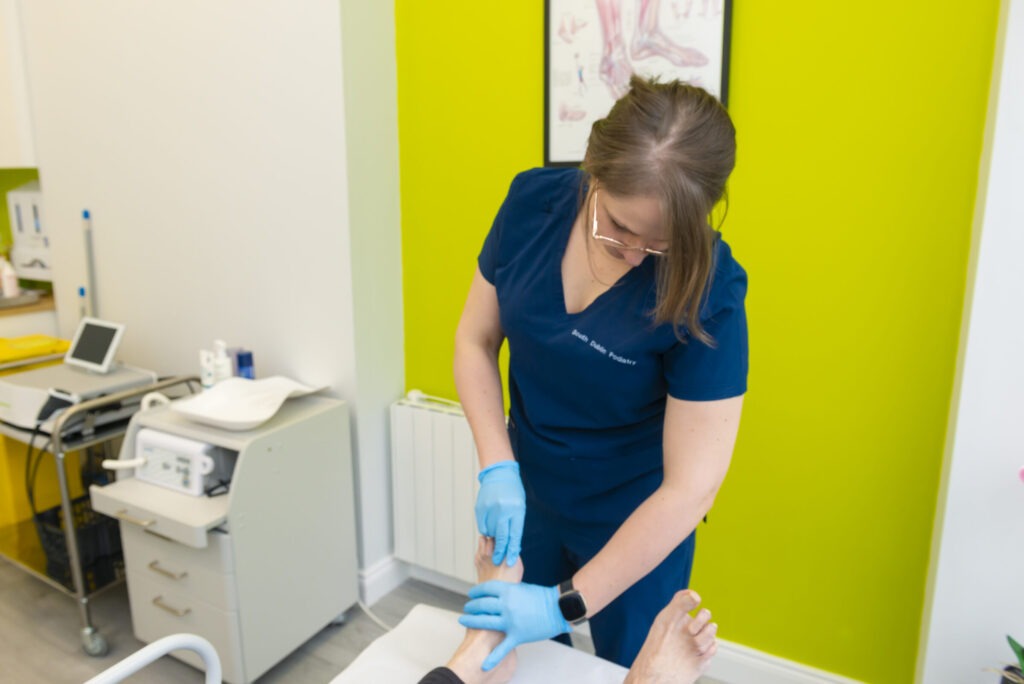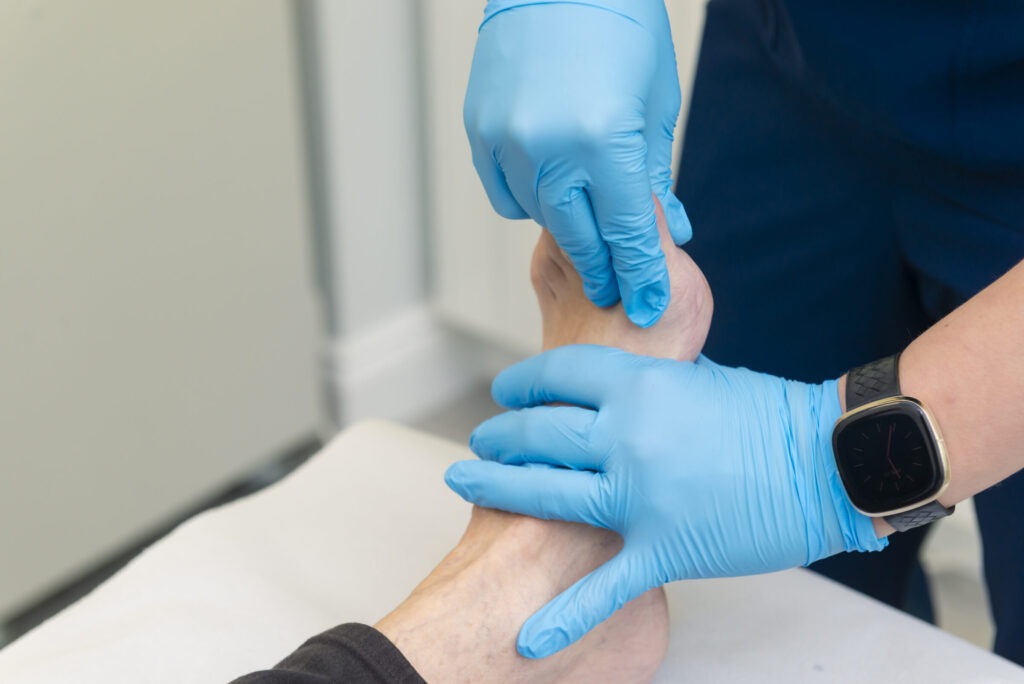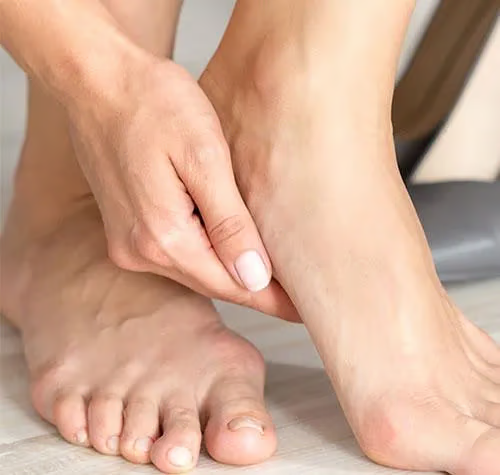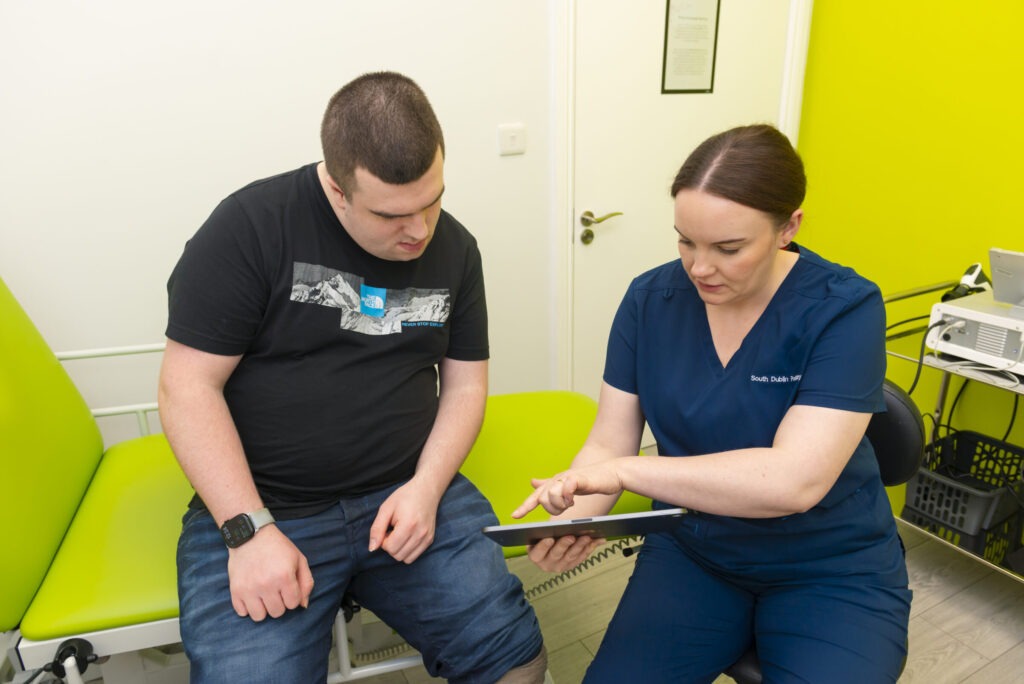
Plantar fasciitis, also known as plantar fasciopathy or plantar heel pain, is one of the most common causes of foot pain and a condition we regularly treat at South Dublin Podiatry. It typically presents as pain along the inside of the heel, especially when taking the first steps in the morning or after sitting for a period of time which then eases once you have been walking around for a few minutes.
This condition is often caused by factors such as poor foot mechanics, prolonged standing, unsuitable footwear, or a sudden increase in activity. Left untreated, plantar fasciitis can become a long-term problem, but with the right approach, it’s very treatable.

At South Dublin Podiatry, we begin with a comprehensive biomechanical examination to determine whether you are experiencing plantar fasciitis or another condition. This allows us to assess your foot mechanics and identify the root cause of your pain. Based on our findings, we then develop a personalised treatment plan tailored to your needs. Our expert team specialises in gold standard, evidence based treatments to get you back on your feet. This may include footwear advice, taping the foot, custom made foot orthotics or extracorporeal shockwave therapy.
At South Dublin Podiatry, we understand how debilitating heel pain can be—whether it strikes first thing in the morning, after sitting for a while, or during everyday activities. If you’ve tried multiple clinics, spent money on orthotics that didn’t work, or been told that an injection is your only option, you’re not alone. Persistent heel pain can make even a short walk unbearable and leave you wondering if you’ll ever return to the activities you love. Our expert team specialises in effective, long-term solutions to help you move comfortably again.

One of the most common causes of plantar fasciitis is actually related to the structure of the foot itself. For instance, if you have flat feet or high arches, you might be more susceptible to developing this condition.
Another factor that can contribute to plantar fasciitis is wearing shoes that don’t offer enough support, particularly when walking on hard, flat surfaces. This is especially noticeable for people who spend extended periods on their feet at work.
Furthermore, carrying excess weight may also increase the likelihood of developing plantar fasciitis. It’s important to take care of your feet and seek treatment if you notice any pain or discomfort. Our team at South Dublin Podiatry can provide you with personalised treatment options and help you get back to the activities you love.

Allow me to clarify the symptoms of plantar fasciitis in a more understandable way.
Plantar fasciitis typically causes pain in three specific areas: the bottom of the heel, the arch of the foot, and especially when getting up.
The pain can worsen over several months and is often described as more severe in the morning or after sitting for extended periods of time. Interestingly, walking can actually help alleviate the pain as it stretches the fascia, but it may return after standing for extended periods of time.

Our experienced and knowledgeable practitioners will examine the following to identify exactly what is causing your Plantar Fasciitis:
Our orthotics are designed with the latest cutting edge technology, to get you back to normal and doing the things you love.
At South Dublin Podiatry, our team of plantar fasciitis experts understands that each person’s needs are unique. That’s why we often create individualised rehab programmes to ensure you get the most out of your orthotics when needed for plantar fasciitis.
And if you want to take a break from wearing your orthotics and slip into those nice shoes you’ve been eyeing, we can help make that possible too!
Our goal is to provide treatments that are gentle and progressive, allowing you to recover from plantar fasciitis and resume your favorite activities as quickly as possible, without experiencing any pain.
We want to help you overcome the limitations that your plantar fasciitis has imposed on you, so that you can return to the things you love doing.
Also we don’t just want to eliminate your plantar fasciitis, we want to provide you with the knowledge and resources necessary to prevent it from returning in the future.
Plantar fasciitis is a common foot condition characterised by inflammation and irritation of the plantar fascia, a thick band of tissue that runs along the bottom of the foot, connecting the heel bone to the toes. It often causes heel pain, especially during the first steps after waking up or prolonged periods of inactivity.
Plantar fasciitis is commonly caused by excessive strain and stress on the plantar fascia. Factors that contribute to its development include overuse, high-impact activities, improper footwear, flat feet or high arches, tight calf muscles, obesity, and certain occupations that involve prolonged standing or walking on hard surfaces.
The main symptom of plantar fasciitis is sharp or stabbing heel pain, typically felt on the underside of the foot near the heel. The pain is often worse in the morning or after periods of rest. It may improve with movement but can worsen after prolonged activity.
Plantar fasciitis is usually diagnosed through a physical examination and a discussion of your symptoms and medical history. Imaging tests such as X-rays or ultrasound may be used to rule out other potential causes of heel pain.
Treatment for plantar fasciitis typically involves a combination of conservative measures, including rest, ice therapy, stretching exercises, nonsteroidal anti-inflammatory drugs (NSAIDs), orthotics, supportive footwear, night splints, and physical therapy. Severe or persistent cases may require corticosteroid injections or, in rare cases, surgical intervention.
The recovery time for plantar fasciitis varies from person to person. With proper treatment and adherence to recommendations, many individuals experience improvement within a few months. However, it can take up to a year or longer for some cases to fully resolve.
It is generally recommended to avoid or modify high-impact activities that aggravate the symptoms of plantar fasciitis. However, low-impact exercises such as swimming, cycling, and gentle stretching can be beneficial. It’s important to consult with a healthcare professional for specific guidelines based on your condition.
To help prevent the recurrence of plantar fasciitis, it’s important to wear supportive and properly fitted footwear, avoid excessive strain on the feet, maintain a healthy weight, engage in regular stretching and strengthening exercises for the feet and calf muscles, and gradually increase activity levels to avoid sudden overuse.
Yes, there are several home remedies that can help alleviate plantar fasciitis symptoms. These include applying ice packs to the affected area, performing stretching exercises, using over-the-counter arch supports or orthotic inserts, wearing supportive shoes or sandals with cushioned soles, and resting the feet whenever possible.
It is recommended to seek medical attention if your heel pain persists for more than a few weeks, if it becomes severe and limits your daily activities, if you experience swelling or redness in the affected foot, or if you develop symptoms in both feet. A healthcare professional can provide an accurate diagnosis and recommend appropriate treatment options.